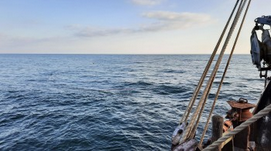The population of Russian sturgeon (A.gueldenstaedtii) continues to grow in the Sea of Azov
The results of long-term monitoring of sturgeon fish in the Sea of Azov, carried out by the Azov-Black Sea branch of VNIRO with the use of the of trawl surveys have shown a continuous increase in the number of Russian and stellate sturgeons in the Sea of Azov since 2014, including in the open part of the sea. At this, not only a growth of the total number has been observed, but as well the building of a multi-age population structure, characterized by an increase in the average weight and size of specimens. For example, the size of the caught Russian sturgeon specimens was 122 cm, while the weight amounted to 20.4 kg. Since 2014, as evidenced by the research studies (Bulgakova et al., 2022; Luzsniak, 2022; Vasev et al, 2023) an increase in the population abundance of these fish species and their biomass is observed in the Azov Sea (from 42 t in 2015 to 998 t in 2022 and significantly more in 2023).
Sturgeon species were constantly presented in the catches of coastal fixed gill nets of fishing crews. All specimens, after the necessary measurements performed by the scientists, were released back into the sea. Samples were also taken for molecular genetic studies to clarify the origin of the caught sturgeon.
This became possible, since in the Sea of Azov all sturgeon hatcheries from which sturgeon were released into natural water bodies for the purpose of stock enhancement, have undergone state molecular genetic certification and registration of broodstocks. The results of certification are updated annually by the Azov-Black Sea Territorial Administration of the Federal Fisheries Agency on the basis of conducting an autumn farmed brood stock assessment.
It is noted that only 50% of the genotypes of sturgeon specimens, inhabited the sea, have been originated from the federal sturgeon hatcheries, which released juveniles of “standard weight” (1.5 – 3 g), while, their share in the total (pcs.) production volume has been above 90%.
At the same time, the State Center for Sturgeon Gene Pool Conservation “Kubanbioresursi” has been conducted releases of different age-graded Russian sturgeon of weight ranged from 0.12 to 4-6 kg since 2013. Thus, gained genetic monitoring data indirectly confirm the high efficiency of different age-graded fish releases, characterized by higher survival rate in the wild.
https://azniirkh.vniro.ru/content/read/azniirkh-news/37146480-17-10-2022
https://azniirkh.vniro.ru/content/read/azniirkh-news/82067682-04-12-2023
https://azniirkh.vniro.ru/content/read/azniirkh-news/89095169-19-04-2023
https://www.kubzsk.ru/news/26881/?ysclid=lipuhan3y6847579536
https://www.wscs.info/sturgeon-release-in-the-river-kuban/
https://www.kubanbioresursi.ru/news-58
https://www.kubanbioresursi.ru/news-32
Luzhniak, V.A. Population Dynamics of Sturgeon Fish (Acipenseridae, Acipenseriformes) in the Sea of Azov. J. Ichthyol. 62, 1404–1418 (2022). https://doi.org/10.1134/S0032945222060157
Bulgakova, T.I., S. N. Kulba and M. M. Piatinskii. Modeling for Scenarios for Stock Recovery of Russian Sturgeon Acipenser gueldenstaedtii in the Sea of Azov in the Absence of Natural Reproduction. J. Ichthyol. 62 No. 2 2022, pp. 254–265.
Vasev A.B., Luzhnyak V.A., Barinova V.V., Vakulenko S.O., Belyaev V.A., Mirzoyan A.V. Results of the investigation of the Azov Sea populations of sturgeon fish species as a part of monitoring the catches by stationary fishing gears along the Kuban coast. Aquatic Bioresources & Environment 6 No 4 2023, pp.68 -78.





